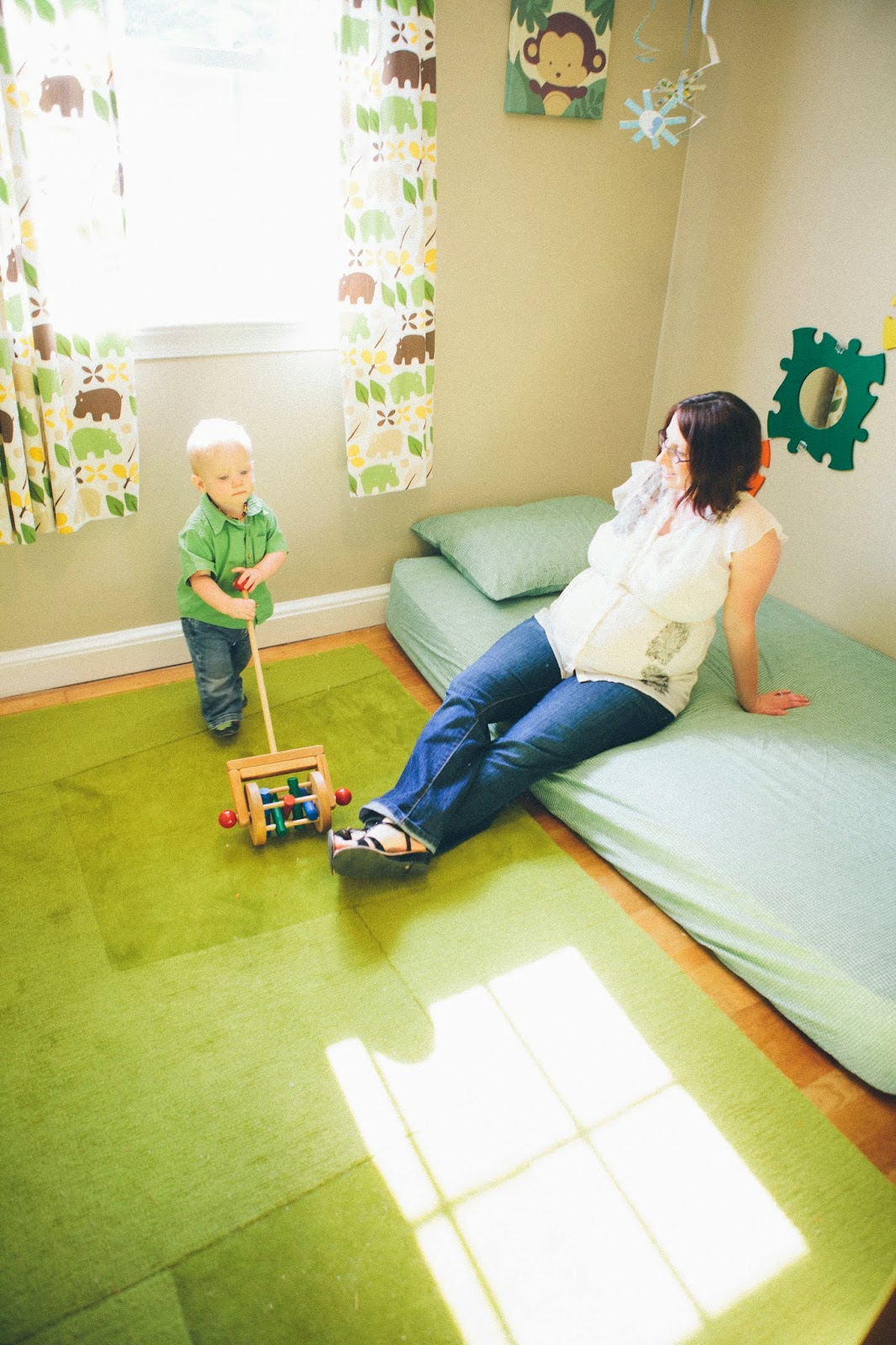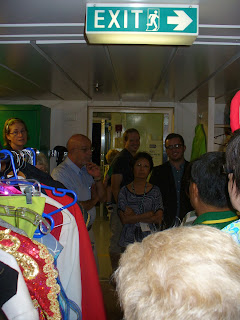Continued from Part 2: The Hard Work of Progress
I went home physically and emotionally exhausted. It was at this point that fear and anxiety set in. I had always—well, from my late teen years when I heard about the Bradley Method through a family I babysat for— truly believed in my body’s ability to birth a baby of its own accord. But here I was, feeling that I’d read my body’s signs wrong, or that they had misguided me, and it was emotionally draining. The length of the labor wasn’t the bad part—I had just told nurse that we'd waited 2.5 years for this baby, we surely could wait a few more days—but the beginnings of the realization that my body might not just make this work had set it. Thankfully, I was still largely a believer, just a believer with some innocence lost. And, I kept on going. I called my Bradley instructor and she was encouraging. At about 3 PM, I started having contractions again. They continued to be painful back labor contractions. I sat in the living room on the ball and watched Netflix to pass the time.
Friend Kelly brought us California Tortilla for dinner around 6. Nachos for me! I was sitting backward on a folding chair in the living room processing through regular, intense contractions again about 5 min apart. Later she shared she could have sworn from my contractions and my reactions that baby was coming very soon, like concerned-we-were-still-at-home-soon.
I decided that I wanted to labor in the tub again since it had felt so good at the hospital. Dave prepared a bath for me and kept me company. It was there that he told me we could name the baby V. We’d long been debating between V and another name. Dave wanted to meet the baby before deciding, whereas I was ready to commit, as I just knew it was the right name. What a great gift to give me a labor boost!
Dave was getting tired so he asked if Jill could come over and help while he slept. She came and kept me company while I continued to labor in the tub. A mere 15 minutes after Dave went to bed, my contractions started to increase in frequency and intensity again, to the point where they were two minutes apart, lasting for almost that whole time, and too painful to talk through. Jill was adamant that it was time to go to the hospital and woke Dave, who took a more relaxed speed in calling Doula K and the Kaiser nurse’s line despite Jill’s continual prodding. We learned that Doula K would not be meeting us at the hospital due to a family issue, but could send her backup doula, who we had never met. That was a big disappointment. We had debated a hospital versus center or home birth until I was about 30 weeks pregnant, and having a doula who was a good fit was key in my agreement to a hospital birth.
We made it back to the hospital at about 10:30 PM and ended up back in the same room as before. Jill followed us in her car came up to the room with us. This time Dr. V was on call. I had seen him a few times during my pregnancy and I knew he was a fairly low-key guy, like Dr. S. We got settled in again with a monitoring strip and another painful heplock. I wanted a progress check and this one showed I was 4 cm and baby was at -1 station.
I was ready to get back into the water. But, Dr. V was against it because I had been in labor for so long. He claimed my water might break and I wouldn’t know. I felt this was a bogus rule, so I drew the bath anyway. But rule follower that I am—I just could not relax in the bath knowing that I was violating his orders. So, I got out of the water and labored on the exercise ball in the room.
Backup doula Doula J showed up and Jill headed out. Doula J didn’t know anything about us or our birth wishes, but because I was in so much pain, she just jumped right into helping me through. It took a leap of faith to throw myself emotionally and physically into the arms of an unknown person, but utilizing a doula had been the hallmark of me agreeing to a hospital birth, so I just abandoned my hesitations and went with it. We soon discovered a bit of kindred spiritedness.
Because I was no longer comfortable in the bath, I felt robbed of my most effective pain-management strategy, which was another emotional blow. Around 1:30 AM Doula J suggested that we put the exercise ball in the shower and she and Dave took turns aiming the spray at the small of my back. This gave me the benefit of the water, but without breaking the rules. It was a brilliant suggestion, and we spent most of the night like this. I would have to get out for monitoring, but then would go right back in to the shower. The shower was a lifesaver. The one big drawback was being cold. I was warm where the water hit, but not elsewhere. Dave and Doula J tried to keep me warm with towels in the shower, but it was never quite enough, and I don’t think I could even recognize that in the moment. I chose to be in the shower because it was the best pain-management choice, but it meant being cold. The in-and-out for monitoring also played into being cold and expending energy. Tradeoffs that seemed small in the moment added up.
A strong and unpleasant sensory memory I have of the labor is of being cold. I associate that with desperation and my increasing loss of control. The previous night in the hospital, I would get cold when I had to get out of the bath for monitoring and then either stay in my wet swimsuit top or put it back on while it was clammy. At home in the bath, the water just couldn’t get deep enough to cover me and it didn’t stay warm, so we draped towels on me to keep warm—but eventually they too would get wet and cold. These may seem like minor details, but I would relive being helplessly cold in my panic attacks. It took me months of processing later to understand where that was coming from, so it is a valuable detail to me.
We kept the lights off in the bathroom, which ended up having the added blessing that the staff backed off on pushing monitoring. I took it as respect for my wishes and niceness, but at one point they genuinely thought we had left the room for a long time.
I don’t remember a whole lot from these hours besides unrelenting pain, exhaustion, and the water on my back. I think a part of my brain shut off in order to keep functioning. The next few paragraphs are pieced together from my medical records, Dave, and flashes of memories that would come to me later.
During the monitoring a little after 3 AM, baby showed some “non-reassuring” heart decelerations on the monitor. Dr. Vu encouraged me to have two bags of IV hydration and extended monitoring. I also agreed to an internal. This showed dilation of 7-8 cm, baby at 0 station and bulging bag of waters. Dr. Vu expressed concern about the strain of a long labor on my body. I don’t remember any of what he said, perhaps because of my nature to trust my body to do this (and my fear of the intervention domino effect). It was obvious that my body was doing its job—ever so slowly—and my contractions were continuing every 3-4 minutes. I think I thought that delivery was nearing, and that perhaps baby would even be born in his sack.
A little before 5:30, I got out of the shower for monitoring, but brought the ball with me and sat on that during the read. While there my water broke and spread down the towel-covered ball and all over the floor.
Dr. V stopped in after my water broke and shared with us the idea that baby might be
occiput posterior (OP). He wanted to do an internal exam to feel and tell me but I refused to avoid the chance of infection now that my water had broken and because I felt like I was now on a delivery clock. I suggested they do an ultrasound rather than an internal, since he didn’t seem to know how to feel a baby’s position by touching my belly. I got a bizarre line about how ultrasound wouldn’t show us, but a bit after 7:30 AM, Dr. V returned with a portable machine that showed baby was head-down and very likely OP.
During that night and early morning, I was much less chatty than the first days. I remember being mostly silent. Or maybe I wasn’t and I just felt silent. I felt silent and alone while in the shower for all of those hours. Not abandoned, but definitely like this was my road alone to conquer. I know that I dozed-off some on the ball. I know that scripture ran through my head a ton, as did worship songs. “I can do all things through Christ who strengthens me,” was a mantra. Verses I didn’t even know that I knew came to my mind and sustained me.
But, eventually, I know that I was miserable and begging and crying for help. I don’t know that I wanted medicine, but I wanted hope and answers. The pain was relentless and unbearable. I felt like I had been tortured for days by a body that was supposed to innately know how to do this. I was tried and sick of people getting me out of my relaxation zone for monitoring I didn’t want in the first place.
But, then something in me changed. I went from desperate to deciding that no one was going to make me do anything I didn’t want to. No more compromises. When I was told it was time for monitoring again, I talked myself into it. I no longer felt the need to rush to do it on their timeline. This was my birth and I did have choices, even beyond the details we’d put in our birth preferences. This is what I had diligently prepared for, for months, for years.
I started using lots of “I” statements out-loud to motivate myself. “I am choosing to get out of the shower.” “I am choosing to get monitored”. I got very articulate. I decided that though I couldn’t take my relaxation with me out of the shower, I could still take my intense focus. I think that it was a gift from God to prepare me for the next step in my labor: meeting Dr. M.
Dr. M started off very unlike the previous doctors. From our first encounter, on the morning of January 4, it was clear that she had her own way of doing things. She yelled into the bathroom where I was laboring in the shower and refused to come in when invited (inviting people into the bathroom rather than me coming out was part of my new assertion strategy). She insisted that she could only meet me if I was in bed and agreed to an internal exam. She didn’t care about my place in labor; she wanted me for monitoring even if I was in a middle of the contraction. She actually asked me what my problem was when I had a hard time moving because of the frequent contractions. When I motivated myself to come out, she told me that she’d talked to our reproductive endocrinologist about me and that this was a special day. I found her reference to our infertility without me first bringing it up very over-personal.
She was high-pressure about doing an internal, but I had decided that I was ready to know where I was at. I don’t remember where I was at, nor did she enter it into my medical records. She asked me my shoe size and then told me that there was no way I could deliver my baby vaginally. (It seems that my small shoe size confirmed to her that I had a small pelvis.) She also said that my pelvis was not shaped the right way, so baby couldn’t come out. This was shocking because Dr. S had told me twice in my pregnancy that my pelvis showed no contradictions for vaginal delivery, even with the pelvic separation that had developed. She told me that with her twenty years of experience with natural birth, I just wouldn’t be able to do it vaginally. Even though she was definite in her negativity, and in her position that we were moving toward a c-section, somehow we did get her to suggest that if the baby turned out of the OP position, there was a chance he could be born vaginally. I was upset by her comments, but I don’t remember believing a word of her talk about my pelvis and inability.
I was, however, motivated to get baby to move. Dr. M suggested adding fluid through my cervix and manually moving baby with her hand. She also suggested laying on my side and stomach (similar to the Bradley relaxation position). I asked for some time to think about it, as I knew to do with all interventions. I didn’t like the idea of introducing anything into my uterus and I was concerned about the relaxation pose. My pelvic separation made laying on my side unbearably painful, and with all of the pain I had already been through, I just didn’t think I could do it.
In retrospect, I find it interesting that I knew to trust the pain of labor and birth and let it guide me, but the pelvic pain was something that truly struck fear into my heart. When I lay on my side, I felt like half of my pelvis was suspended, unsupported in space and that I might actually do serious damage that way. It intrigues me to think that I felt empowered to deal with the pain of labor without meds, but not with the unnatural pelvic pain.
Doula J helped us walk through the low tech ways to move baby: namely a slow dancing move and leaning over the ball. We tried both. The extent of my physical exhaustion became apparent. Any of it was just too much for me to sustain. While I was on the ball, Doula K rejoined our group. I thought that Doula J would leave, and was bummed out by that idea since we had bonded. But, when Doula K and Doula J talked about Dr. M’s approach to me, they decided that both would stay. They both had previous experience with Dr. M that was not supportive of a natural birth or a relaxed environment.
With Dave and the doulas, we talked through the pros and cons of the various options. I couldn’t bear the thought of laying on my side without some relief, let alone the doctor trying to manually turn the baby. I was so, so sad to be considering an epidural, but with my renewed mental clarity and resolve and ownership of my experience I could see that it seemed like the path most likely to avoid a c-section given my physical exhaustion and the new, hostile environment. After a decade of envisioning an unmedicated birth, meds seemed to be the sanest path to a vaginal birth. Dr. M never mentioned an epidural—the one thing I respected about her care—but I didn’t think I could get through her proposed steps without it. Even with the burst of clarity-of-mind I was having, my strength and sanity were giving out from the work of the previous days. Doula J and Doula K walked Dave and I through our options and questions, but did not offer their opinion. I later learned that they both though this was wise move and knowing Dr. M’s style feel certain she would’ve moved me to a c-section quickly had I not gone this route. (Far out from the birth, I also believe this.)
We decided that I would ask for one more internal to see if maybe I was more ready than I thought, if maybe my desperate emotions had actually been a signpost of transition followed by the resolve of getting ready to push. But if not, I would get the epidural to facilitate the interventions: side-laying first and the fluid if that didn’t work. When Dr. M came in, I forgot to ask for the internal and just said that I was ready to move forward and that I wanted an epidural to facilitate things. I beat myself up emotionally over forgetting that in the months after the birth. It’s not that an epidural is bad, it’s just that since age 16 I had felt strongly about natural birth. I felt like a sell-out, despite also recognizing the wisdom of the compromise in a hostile setting. Despite that regret, I do think that decision was wise. I’ll skip ahead and share that the epidural helped me relax enough for baby to descend and I was able to get in some rest before the most challenging part of the birth. But, we’ll get there soon enough…
Concludes in Part 4: Delivery.Labels: Baby, Birth, Parenting, Pelvic Instability



















-1.jpg)





























